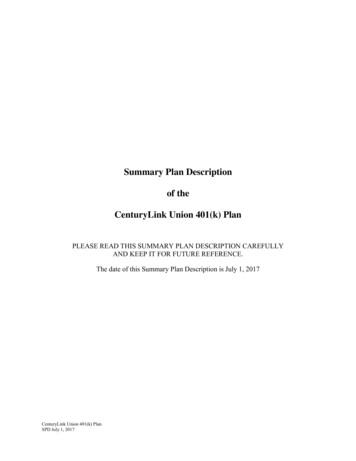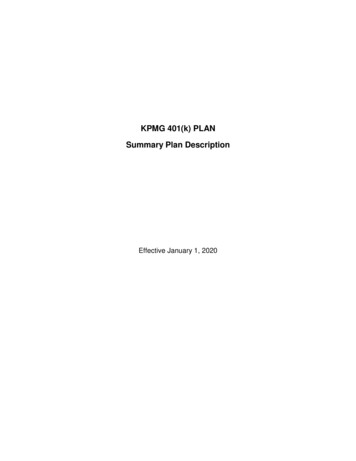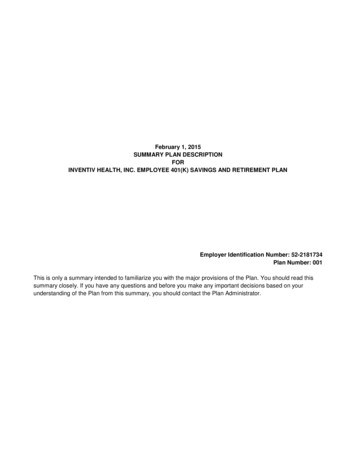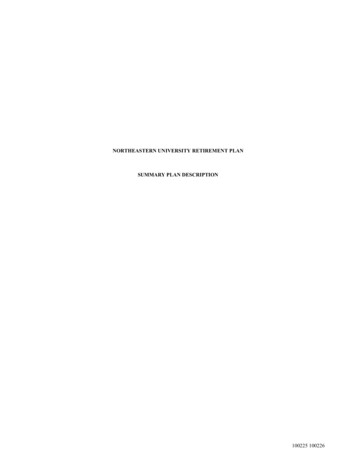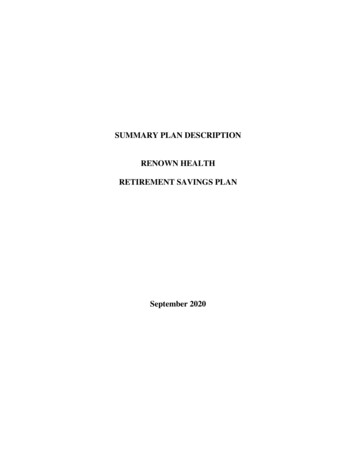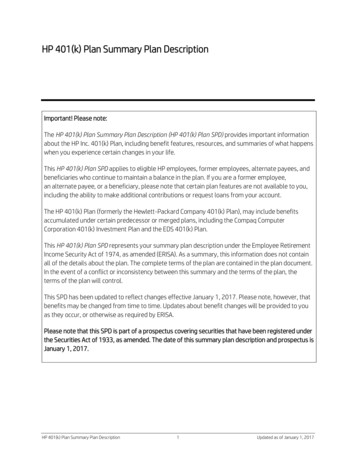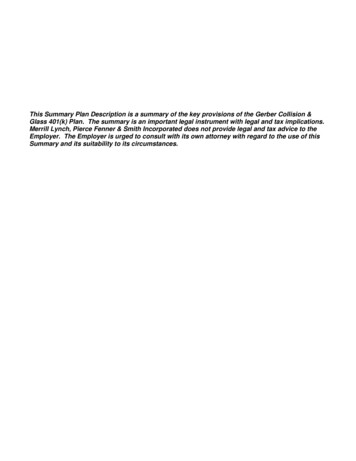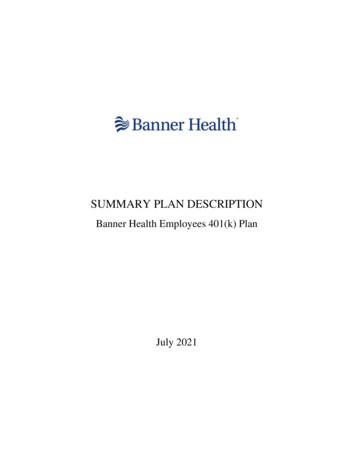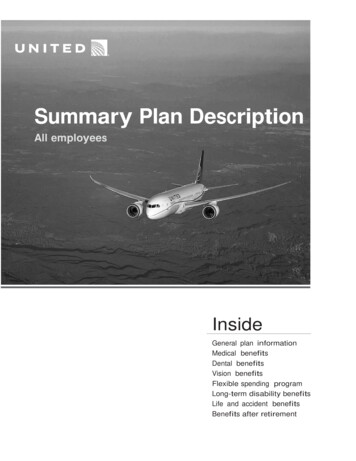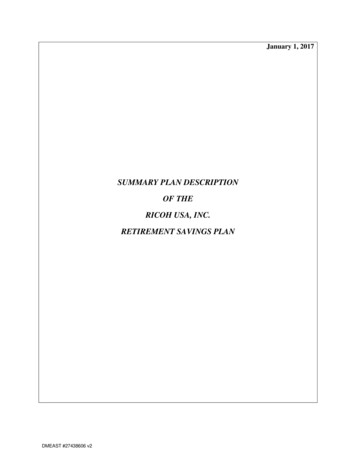
Transcription
January 1, 2017SUMMARY PLAN DESCRIPTIONOF THERICOH USA, INC.RETIREMENT SAVINGS PLANDMEAST #27438606 v2
SUMMARY PLAN DESCRIPTIONOF THERICOH USA, INC.RETIREMENT SAVINGS PLANTable of ContentsPageGENERAL PLAN INFORMATION . 1Name of Plan. 1Plan Sponsor . 1Type of Plan . 1Plan Year . 2Trustee. 2Recordkeeper . 2Retirement Plans Committee and Administrator . 2Agents for Service of Legal Process . 2Identification Numbers . 2PARTICIPATION IN THE PLAN . 3CONTRIBUTIONS TO THE PLAN . 3Basic and Supplemental Contributions . 3Matching Contributions . 4Saver’s Credit on Federal Income Tax . 6Catch-up Contributions . 6Rollover Contributions. 6YOUR PLAN ACCOUNTS . 7INVESTMENT FUNDS . 7IKON Stock Fund . 9About the RSP’s Investment Responsibilities . 9VESTING . 10RETIREMENT . 11Retirement Benefit . 12Disability Benefit . 12TERMINATION OF EMPLOYMENT . 12Permanent Shutdown . 12DMEAST #27438606 v2i
If You Leave Your Employer . 12Military Service . 14DEATH BENEFITS . 14PAYMENT OF YOUR BENEFITS . 14Form of Distribution . 14Some Points to Consider . 14BENEFICIARY DESIGNATION . 15WITHDRAWALS . 15Withdrawal Rules. 16Hardship Withdrawals . 16LOANS . 17CLAIMS FOR BENEFITS . 18Initial Claim . 18Denial of Claim . 18MERGED AND PREDECESSOR PLANS . 19Your Plan Accounts . 19Vesting . 20Death Benefits . 21Form of Distribution . 21Withdrawals . 22MISCELLANEOUS PROVISIONS . 23Reports to Participants . 23Non-Assignment of Benefits. 24Limits on Benefits . 24Federal Tax Treatment . 24Plan Amendment and Termination . 25Top-Heavy Rules . 26YOUR RIGHTS UNDER ERISA . 26Receive Information About The RSP and Benefits . 26Prudent Actions by RSP Fiduciaries . 26Enforce Your Rights . 27Assistance with Your Questions . 27APPENDIX A – PARTICIPATING EMPLOYERS . 28DMEAST #27438606 v2ii
SUMMARY PLAN DESCRIPTIONOF THERICOH USA, INC.RETIREMENT SAVINGS PLANThis is a summary of the Ricoh USA, Inc. Retirement Savings Plan (the “RSP”)as in effect on January 1, 2017. Ricoh USA, Inc. and certain of its participating Employers haveadopted the RSP for the benefit of eligible employees. A complete list of these participatingEmployers is provided in Appendix A at the end of this summary.The RSP is intended to qualify under section 401(a) of the Internal Revenue Codeand to be in compliance with all applicable requirements of the Employee Retirement IncomeSecurity Act of 1974, as amended (“ERISA”), including provisions governing reporting,disclosure, participation, vesting and fiduciary responsibility. This is a general description of theterms of the RSP. If there is any conflict between this summary and the plan document, the termsof the plan document will govern. You should keep this summary with your permanent records.GENERAL PLAN INFORMATIONName of PlanThe official name of the plan is the Ricoh USA, Inc. Retirement Savings Plan.Prior to January 1, 2016, the name of the plan was the Ricoh Americas Corporation RetirementSavings Plan. Prior to April 1, 2011, the plan consisted of two separate plans known as the IKONOffice Solutions, Inc. Retirement Savings Plan and the Ricoh 401(k) Savings Plan.Plan SponsorThe RSP is sponsored by Ricoh USA, Inc. (“Ricoh”) located at 70 Valley StreamParkway, Malvern, PA 19355.Type of PlanThe RSP is a 401(k) profit sharing plan. The RSP was originally known as theStock Participation Plan (“SPP”) and it contains assets from numerous other plans that have beenmerged into it over the years, including the Ricoh 401(k) Savings Plan, Alco StandardCorporation Defined Contribution Plan (“DCP”), the Alco Standard Corporation CapitalAccumulation Plan (“CAP”), the Pentax Ricoh Imaging Americas Corporation 401(k) Plan (the“Pentax Plan”), and the Ricoh Production Print Solutions LLC US Savings Plan (the “RPPSPlan”). Special rules may apply to participants whose accounts contain assets from the SPP or amerged plan. Many of these special rules are described in separate sections at the end of thissummary (see the Merged and Predecessor Plans section of this summary).DMEAST #27438606 v2
Plan YearThe books and records of the RSP are maintained on a plan year basis. The planyear for the RSP is the 12-month period beginning each January 1st and ending on the followingDecember 31st.TrusteeThe Trustee is Northern Trust Company. The Trustee holds all RSP assets in atrust fund (the “Fund”). The Trustee may be reached at:50 South LaSalle StreetChicago, IL 60603RecordkeeperAon Hewitt (“Recordkeeper”) acts as recordkeeper for the RSP. You can contactthe Recordkeeper by visiting the Your Benefits Resources website athttp://resources.hewitt.com/rac or by calling Benefits Express at 1-800-953-2526.1Retirement Plans Committee and AdministratorThe Ricoh Retirement Plans Committee (the “Committee”) has generalresponsibility for administering the RSP, selecting the available investment funds, appointing theAdministrator and reviewing claims for benefits that have been denied. The Vice President, RACBenefits & HRIS is the Administrator and has responsibility for reviewing initial claims forbenefits and for the day-to-day administration of the RSP. Both the Committee andAdministrator may be reached at:Ricoh Benefits Dept.70 Valley Stream ParkwayMalvern, PA 19355Telephone: (610) 296-8000Agents for Service of Legal ProcessLegal process may be served on the Trustee or on the Administrator.Identification NumbersThe RSP is identified by the tax identification number assigned to Ricoh USA,Inc. of 23-0334400 and the plan number of 099.1Your Benefits Resources and Benefits Express are trademarks of Aon Hewitt.DMEAST #27438606 v22
PARTICIPATION IN THE PLANYou can become a participant as soon as administratively practicable followingthe day on which you meet the following conditions: you are a regular employee of an Employer (see below), and you are not covered by a collective bargaining agreement, unless theagreement specifically provides for your participation in the RSP.You are considered a regular employee if you are expected to or actually docomplete 500 or more “hours of service” during a plan year for an Employer. You are creditedwith 190 hours of service for each month of employment in which you earn at least one hour ofservice.You will not be considered a regular employee if you are a leased employee or anindependent contractor. The classification to which you are assigned by your Employer is finaland binding for purposes of participating in the RSP, and will not be changed even if a court orother entity later determines that you are an employee for employment tax or other purposes.You earn an hour of service for each hour for which you are paid or entitled to bepaid by your Employer or any affiliated company for the performance of employment duties,including hours for work performed with an acquired company prior to its acquisition by Ricoh.If you are paid for non-working periods such as holidays, vacations, and sick time, you will alsoreceive credit for hours of service for those periods. However, no more than 501 hours of servicewill be credited for any single, continuous, non-working period.You will receive no credit for hours of service when you are receiving paymentsmade solely for purposes of workers’ compensation, unemployment compensation, short-term orlong-term disability insurance, or for reimbursement of medical expenses.CONTRIBUTIONS TO THE PLANYour benefit from the RSP is provided by matching contributions made by yourEmployer and by any basic, supplemental, catch-up and rollover contributions you may chooseto make.Basic and Supplemental ContributionsAlthough you are not required to make contributions to the RSP, eligibleemployees have the opportunity to make basic and supplemental contributions. You maycontribute from 1% to 6% of your annual compensation as basic contributions and an additional1% to 44% of your annual compensation as supplemental contributions. Currently, highlycompensated employees (“HCEs”) are limited to contributing from 1% to 8% of their annualcompensation, or such other percentage as may be designated by the Administrator.Your basic and supplemental contributions may be made on a before-tax basis ora Roth after-tax basis. It is important to understand the differences in the way these contributionsDMEAST #27438606 v23
are taxed both when they are deposited and when they are withdrawn when you are decidingwhat types of contributions you want to make.The money you contribute on a before-tax basis is deducted from your paycheckbefore federal income taxes are calculated. The amount you contribute in before-tax dollarsreduces your taxable income, so you pay less tax now. The taxes you save are deferred, noteliminated. The tax on your before-tax contributions is due when the money is distributed orwithdrawn.Money you contribute on a Roth after-tax basis goes into the RSP after federalincome taxes have been deducted. Earnings on Roth after-tax contributions are distributed taxfree as long as you receive a “qualified distribution.” See the Miscellaneous Provisions –Federal Tax Treatment section of this summary for more information.The Internal Revenue Code limits the amount which you may contribute on acombined before-tax basis and Roth after-tax basis in any one calendar year to a 401(k) plansuch as the RSP. The annual limit is subject to change and may be adjusted for inflation. Thelimit for the 2017 calendar year is 18,000.Basic and supplemental contributions are made through payroll deductions at thepercentage you elect. You may change or cancel your deduction percentage through the YourBenefits Resources website at http://resources.hewitt.com/rac or by calling Benefits Express at 1800-953-2526. After canceling your payroll deduction order, you may resume payroll deductioncontributions by calling in a new payroll deduction order. Any change will take effect as soon asadministratively practicable after it is made.For purposes of determining how much you may contribute to the RSP, yourannual compensation is defined as your regular salary or wages, including commissions, yourbasic and supplemental contributions, and any elective contributions to a company-sponsoredcafeteria plan. Your compensation does not include overtime, bonuses, incentive pay, severancepayments, any elective contributions to any deferred compensation plan or other extra pay.Under federal law, the compensation taken into account for RSP purposes iscapped. The cap may be adjusted in later years, but for 2017 is 270,000. HCEs may be affectedby other rules that cap the amount of contributions they may make. If these rules affect you in aparticular plan year, your contributions may be limited prospectively during the year or yourexcess contributions (and any earnings thereon) will be taken out of the Fund and will be paid toyou after the end of that plan year. The contributions and earnings, if any, returned to you mustbe included in your taxable income. The Administrator will inform you if you will be affected.Matching ContributionsWhen you have completed one Anniversary Year (a 12 month period beginningon your date of hire) and you complete at least 500 hours of service during that AnniversaryYear, your Employer will begin to “match” your basic contributions by making a contribution tothe RSP on your behalf. If you do not complete at least 500 hours of service during your firstAnniversary Year, the Employer will begin to match your basic contributions after the end of anyPlan Year in which you complete at least 500 hours of service. The matching contribution youDMEAST #27438606 v24
receive depends on your hire date and your Employer. Unless you are an “Enhanced MatchingContribution Participant” (as discussed below) you are a “Standard Matching ContributionParticipant.” As a Standard Matching Contribution Participant, your Employer will contribute50% of the amount of your basic contributions to the RSP (the “Standard MatchingContribution”). So, if your annual compensation is 40,000 and your basic contributions are 6%of your compensation (resulting in a basic contribution of 2,400) your Employer will make amatching contribution on your behalf of 1,200 (50% of 2,400).You will be an Enhanced Matching Contribution Participant if you meet thecriteria in (1) or (2) below and either remain employed or were involuntarily terminated with atleast 5 Years of Matching Service, but rehired within 6 months of the date of the involuntarytermination.(1) you were hired before July 1, 2004 and were previously eligible toparticipate in the IKON Office Solutions, Inc. Retirement Savings Plan; or(2) you were hired before October 1, 2009 and were previously eligible toparticipate in the Ricoh 401(k) Savings Plan.If you are an Enhanced Matching Contribution Participant, your matchingcontribution will be based on your Years of Matching Service, as follows:Years of Matching ServicePercentage of BasicContributions Matched1-910-1415-1920-2425-2930 60%70%80%90%100%125%This enhanced matching contribution formula will only apply to EnhancedMatching Contribution Participants. Therefore, if you were hired (or rehired other than in thecircumstance described above) on or after July 1, 2004 or October 1, 2009, as applicable, youwill have the Standard Matching Contribution formula (50% of basic contributions) apply andwill not be eligible for the enhanced matching contribution formula.You earn a Year of Matching Service for each completed 12-month period ofemployment with your Employer. Separate periods of employment are added together todetermine your Years of Matching Service. Remember, how many Years of Matching Serviceyou have is only relevant if you are an Enhanced Matching Contribution Participant.Regardless of your hire date, the matching contribution is made after eachcalendar quarter ends. You must be employed by your Employer (including absent on leaveprotected by the Family Medical Leave Act (“FMLA”)) on the last day of the quarter to receivethe matching contribution for that quarter.DMEAST #27438606 v25
Saver’s Credit on Federal Income TaxIn addition to the Employer matching contribution, if you meet certain incomelimits, you may be able to claim the “Saver’s Credit” on your federal tax return. The Saver’sCredit acts like a matching contribution from the federal government to you. Generally speaking,the Saver’s Credit is available to individuals over age 17 who are not full-time students orclaimed as a dependent on someone else’s tax return, and who have adjusted gross income thatdoes not exceed certain limits. The limits for the 2017 taxable year are as follows:Married filing jointlyHead of householdSingle or married filing separately 62,000 46,500 31,000If you are eligible, you can claim a credit between 10% and 50% of up to 2,000of your contribution to the RSP. How much you can claim depends on your income, but ingeneral, the lower your income, the higher the amount you can claim. If you are interested in theSaver’s Credit, contact the Recordkeeper or a tax advisor for more detailed information abouteligibility and deductible amounts.Catch-up ContributionsIn addition to basic and supplemental contributions, you may be able to make“catch-up” contributions to the RSP. If you are age 50 or older (or will turn age 50 before the endof the calendar year) you can contribute an additional amount to the RSP each year, beginning inthe year in which you reach age 50. The maximum amount you can contribute each year as acatch-up contribution is 6,000. Catch-up contributions may be made on a before-tax basis or aRoth after-tax basis.If you elect to make catch-up contributions, they will be made by payrolldeduction over the course of the year. Your contributions will only be counted as catch-upcontributions if you already make the maximum basic and supplemental contribution available toyou. The maximum amount of basic and supplemental contributions you can contribute canchange over the year depending on changes in your compensation or meeting IRS limits,including the limits that apply to HCEs. If you intend to make the maximum catch-upcontribution, you should monitor your account throughout the year to make sure you remain ontarget. In addition, because these factors can change during the year, your Employer may have toreturn certain amounts to you or recharacterize some or all of your catch-up contribution as abasic or supplemental contribution at the end of the year, even if that means you will make lessof a catch-up contribution than the maximum dollar limit.Rollover ContributionsIf you have money held in another retirement plan or individual retirementaccount, you may be able to transfer or “roll over” that interest to your rollover account in theRSP. Any amount that is rolled over to the RSP will be credited to your rollover account in theFund. You are 100% vested in your rollover account and will not forfeit the amount in yourrollover account if you leave your employment with the Employer for any reason.DMEAST #27438606 v26
You must provide specific documents to the Recordkeeper before your request tomake a rollover contribution is approved. The rules that apply to rollovers are complex. If youwish to make a rollover, contact the Recordkeeper at the Your Benefits Resources website athttp://resources.hewitt.com/rac or by calling Benefits Express at 1-800-953-2526.YOUR PLAN ACCOUNTSFor recordkeeping purposes, your Account is divided into several sub-accounts.These are the: Employee Account, which holds before-tax and Roth after-tax basic,supplemental and catch-up contributions and all earnings and lossesthereon. Employer Account, which holds employer contributions such as matchingcontributions and all earnings and losses thereon. Rollover Account, which holds any rollover savings you may havecontributed to the RSP and all earnings and losses thereon.INVESTMENT FUNDSYou may choose how the funds in your Employee Account, your EmployerAccount and your Rollover Account will be invested. If you do not make an affirmative choicehow to invest your Employee and Rollover Accounts, they are invested in a default fund chosenby the Administrator. If you do not make an affirmative choice as to how your EmployerAccount is to be invested, it will be invested in the same manner as your Employee Account (ifyou have made an affirmative investment choice with respect to your Employee Account) or inthe default fund chosen by the Administrator. As of January 1, 2014, the default fund chosen bythe Administrator is the Vanguard Balanced Index Fund.You will be asked to make an investment election when you first enroll in theRSP. Your election must be in whole percentages that total 100%. Once you have enrolled, youmay change your choice of funds and/or the percentage invested in each fund at any time. Investment Election. You may change the investment election for yourfuture contributions or matching contributions through the Your BenefitsResources website at http://resources.hewitt.com/rac or by calling BenefitsExpress at 1-800-953-2526. If you give notice of your election change tothe Recordkeeper by 12:00 a.m. (midnight) Eastern Time on a businessday on which the New York Stock Exchange (NYSE) is open, yourinvestment election will generally take effect as of the close of the nextbusiness day that the NYSE is open. Fund Reallocation. You may reallocate your existing account balancesthrough the Your Benefits Resources website athttp://resources.hewitt.com/rac or by calling Benefits Express at 1-800-DMEAST #27438606 v27
953-2526. If you give notice of your fund reallocation to the Recordkeeperby 4:00 p.m. Eastern Time on a business day on which the NYSE is open,your election will generally take effect as of the close of business that day.Fund reallocations made after 4:00 p.m. (Eastern Time) will generally takeeffect as of the close of the next business day that the NYSE is open.You may invest all or any portion of your accounts in the funds listed below.Information about these funds will be distributed separately and you may request additionalinformation by contacting the Recordkeeper by visiting the Your Benefits Resources website athttp://resources.hewitt.com/rac or by calling Benefits Express at 1-800-953-2526: Stable Value Fund Vanguard Balanced Index Fund Loomis Sayles Core Plus Fixed IncomeFund Vanguard Institutional Index Fund Vanguard Total Stock Market Index Fund T. Rowe Price Equity Income Fund BlackRock LifePath Index Retirement Portfolio Vanguard PRIMECAP Fund BlackRock LifePath 2020 Portfolio Wellington SMID Cap Research EquityFund BlackRock LifePath 2025 Portfolio Dodge & Cox International Stock Fund BlackRock LifePath 2030 Portfolio American Funds Group EuroPacificGrowth Fund BlackRock LifePath 2035 Portfolio BlackRock LifePath 2040 Portfolio Vanguard Total Bond Market Index Fund BlackRock LifePath 2045 Portfolio JP Morgan Diversified Real Return Fund BlackRock LifePath 2050 Portfolio Vanguard Global Equity Fund BlackRock LifePath 2055 Portfolio Vanguard Total International Stock IndexFund BlackRock LifePath 2060 PortfolioThe selection of investment funds is subject to change if the Committee deems achange necessary and/or prudent. Information concerning the historical performance andfinancial data of the investment funds described above can be obtained from the Your BenefitsResources website at http://resources.hewitt.com/rac or by calling Benefits Express at 1-800953-2526. Each investment fund has different objectives, expected rates of return and risks. Noinvestment can guarantee a certain rate of return or be guaranteed against loss. Broker ortransaction fees and other investment charges, fees and expenses associated with therecordkeeping for and administration of the RSP may be paid from RSP assets and chargedagainst participants’ accounts or may be paid directly from the investment fund return.DMEAST #27438606 v28
IKON Stock FundThe IKON Stock Fund, which invested primarily in IKON common stock, wasavailable as an investment option under the RSP until October 31, 2008, when Ricoh acquiredIKON. Between October 28, 2007 and October 31, 2008, the fund was closed to additionalinvestment and reinvestment. The portion of your RSP accounts invested in the IKON StockFund on October 31, 2008 was reallocated in accordance with your direction. If you did notprovide any direction, then your investment was reallocated to a default fund selected by theAdministrator.About the RSP’s Investment ResponsibilitiesThe RSP is intended to comply with section 404(c) of the Employee RetirementIncome Security Act of 1974 (“ERISA”) and accompanying regulations. This means that theRSP permits participants to direct the investment of their accounts, including contributionswhich may have been automatically invested in a default fund.You have the responsibility to decide how your account is invested. Theindividuals who otherwise would be responsible for making investment decisions (the“fiduciaries” of the RSP) will not be liable for any losses that result directly from yourinvestment instructions. Thus, while the fiduciaries have chosen the investment funds that areavailable under the RSP, you are solely responsible for choosing how to invest your accountamong those funds and the fund managers are solely responsible for investing the moneyentrusted to them.For your long-term retirement security, you should give careful consideration tothe importance of a well-balanced and diversified investment portfolio, taking into account all ofyour assets, income and investments. You should be aware that there is a risk to holdingsubstantial portions of your assets in the securities of any one company, as individual securitiestend to have wider price swings, up and down, in short periods of time, than investments indiversified funds.You should periodically review your investment decisions and consult with
The official name of the plan is the Ricoh USA, Inc. Retirement Savings Plan. Prior to January 1, 2016, the name of the plan was the Ricoh Americas Corporation Retirement Savings Plan. Prior to April 1, 2011, the plan consisted of two separate plans known as the IKON Office Solutions, Inc. Retirement Savings Plan and the Ricoh 401(k) Savings Plan.


